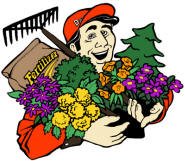Today is Arbor Day so don’t forget to do your part in the "greening of
If your ground is of good tilth and drained well many vegetables can be planted this week as long as the garden is workable such as lettuce, cauliflower, broccoli, sweet corn, beans, potatoes, radishes, carrots, kohlrabi, collards and so on.
I know we’re all anxious to plant tomato and pepper plants but forget it as it’s still too early no matter what the forecast is like for the next couple of weeks.
Our perennial house opens today, April 24th so that you’ll be able to look around for your old favorites as well as some of the newest perennials on the market.
Two of the most interesting of perennials are the new Heuchera called ‘Plum Royale’ that I spotted at a nursery last fall and a new red coneflower called, of all things, ‘Tomato Soup’! These perennials will be available a little later about the first week of the merry month of May.
A new variety of coneflower from last year that is ready now is ‘Tiki Torch’ that is a bright electric orange.
It seems that Heucheras and Coneflowers have been "bred to death" but other note worthy perennials are the newer pink Lily-of-the-Valley, Yarrow ‘Sunny Seduction’ that is a clear yellow and more Evison Clematis varieties that bloom and bloom and bloom!
We know that some of you are antsy to get into our annual house, but we won’t let you in there until May Day as it’s still too early and were still preparing the house for your viewing.
On another note, some of you have said that you rarely see me. I am somewhere here at the nursery as you may at times hear my voice on one of our two-way radios answering the salesperson’s or customer’s questions. Sometimes I choose to stay in the background because of my lack of sleep and the long hours.
However, be assured that I’m always glad to see all of you even though you might perceive I am not because it’s possible that I’m half asleep!
Happy Planting!
Tom



